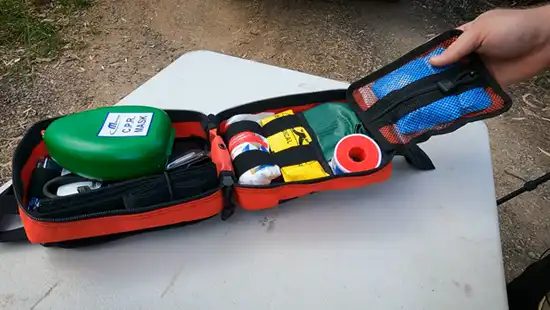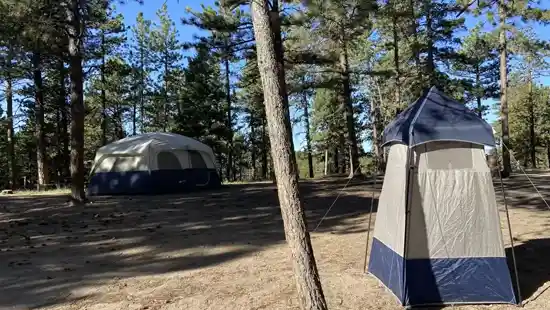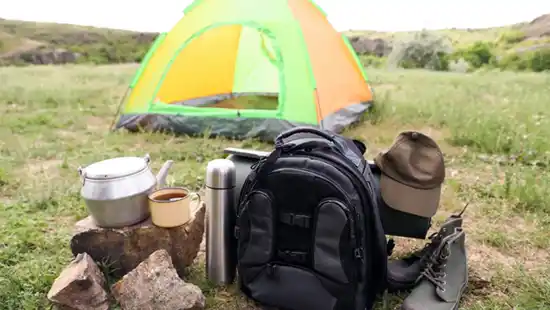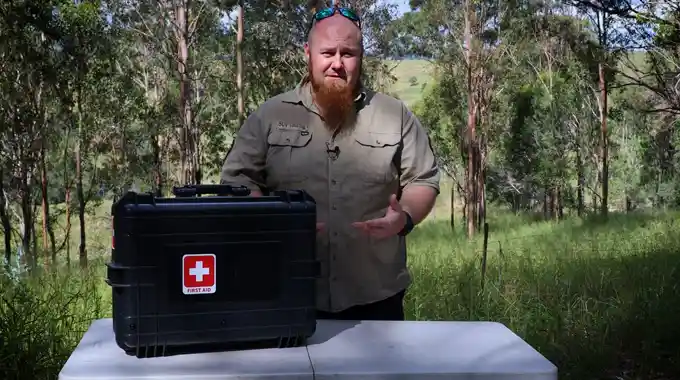Last Updated on April 13, 2023
This is crucial information to know if you’re camping because if something goes wrong and you don’t have the right first aid supplies, you could be in trouble. It can be hard to know what to bring when camping, especially if it’s your first time. You could potentially need many things, and forgetting something important is easy.
A first aid kit is essential for any camper. You never know when something might happen while you’re out camping, so it’s essential to be prepared and know; what do you put in a first aid kit for camping.
We have put together a list of the essential items you need to include in your first aid kit for camping. With this information, you’ll be prepared for anything that comes your way while you’re out in nature. This will help make sure that you have everything you need to stay safe while enjoying the great outdoors.
What Do You Put In a First Aid Kit For Camping: Essential Medical Kits

When packing for a camping trip, it’s essential to include a first aid kit. But what should you put in it? Here’s a list of essential items:
Bandages: A bandage is a piece of material used either to support a medical device such as a dressing or splint or on its own to stop bleeding. There are many different types of bandages, each with its specific uses.
For example, adhesive bandages are commonly used to cover minor cuts and scrapes, while gauze bandages wrap and support more considerable injuries. Bandages can also apply pressure to an injury, which can help stop the bleeding.
Bandages can protect wounds from infection by keeping them clean and moist. Keeping a few different bandages on hand is an excellent way to be prepared for any type of injury.
Antiseptic: Antiseptic is an essential item in any first-aid kit. It can prevent infection in cuts and scrapes and can also be used to clean wounds. Bandages and gauze are also necessary to cover damages and protect them from further injury.
Pain relievers like ibuprofen can reduce swelling and discomfort, while insect repellent can keep bugs away from open wounds.
Pain relievers: There are a few reasons why you might want to keep pain relievers on hand while camping. When you experience any kind of pain or discomfort, having pain relievers can help you get through the day.
If you are hiking or engaging in any other strenuous activity, pain relievers can help you manage any soreness or inflammation. Especially if you have any existing medical conditions requiring medication, it is always a good idea to have an extra medicine supply while camping.
It is likely that if you are camping with young children, they may experience some minor injuries or accidents; pain relievers can help ease their discomfort.
Antihistamine: Antihistamines are a must-have for any first-aid kit, especially camping. Histamine is a hormone the immune system produces that helps protect the body against infections. Histamine can also cause allergic reactions, such as hives, itching, and swelling.
Antihistamines help to relieve these symptoms by blocking the effects of histamine. They can be taken orally or applied topically and are available in prescription and over-the-counter formulations.
When choosing an antihistamine for your first-aid kit, select one appropriate for your needs. For example, if you have asthma or other breathing problems, you will need an antihistamine that does not contain epinephrine.
And if you are camping in an area where mosquitoes are a problem, be sure to choose an antihistamine that also repels insects. You can be prepared for any potential camping emergencies by including an antihistamine in your first-aid kit.
Tweezers: Tweezers are an essential tool for any first aid kit and are especially useful for camping. You can use tweezers to remove splinters, ticks, and other foreign objects from the skin. They can also help apply bandages and ointments to minor cuts and scrapes.
You can help start a fire in an emergency using tweezers. The small, sharp tip of the tweezers can be used to create a spark that can then be used to ignite kindling. Tweezers are a versatile and essential tool that should always be kept in a first aid kit when camping.
Safety pins: A first aid kit is an essential item for any camping trip. Safety pins can are used in various ways, from securing a bandage to holding together a ripped piece of clothing. You can also use safety pins to remove splinters and ticks.
Safety pins can be used to make a makeshift splint in the event of an injury. While they may not be the most comfortable option, they can be a lifesaver in an emergency. So, next time you are packing for a camping trip, include a few safety pins in your first aid kit. You never know when you might need them.
Scissors: An excellent adventure medical kit must be on a camping trip. One of the essential items to pack is a pair of scissors. Scissors can be used to cut away clothing from an injured limb or to remove bandages that have become stuck.
A good pair of scissors should always be included in any first aid kit for camping. While it may seem like a small item, scissors can be extremely useful in various situations.
Space blanket: A space blanket should always be included in a first aid kit, especially when camping. Also known as an emergency blanket, a space blanket is made of highly reflective material that helps to retain heat.
This can be extremely useful in many situations, such as if someone suffers from shock or hypothermia. Space blankets are also lightweight and compact, making them easy to carry in a backpack or purse.
They are inexpensive, so there is no excuse not to have one on hand. Whether you are preparing for a camping trip or just want to be prepared for any emergency, a space blanket should be at the top of your list.
With these items in your first aid kit, you’ll be prepared for any minor mishaps on your camping trip.
Common Injuries that Happen While Camping

When most people think of camping, they picture a peaceful nature outing with fresh air and marshmallows. While camping can be a fun and exciting way to spend time outdoors, it is essential to be aware of the potential risks. Here are some kinds of injuries that occur while camping:
- Burns: Be careful when using a campfire, whether cooking or heating. Burns is one of the most common types of injuries sustained while camping, so keeps an eye on any open flames.
- Insect Bites: Mosquitoes, ticks, and other insects can carry diseases, so it’s essential to take precautions against them. Wearing long sleeves and pants can help to reduce the risk of being bitten, as can using insect repellent.
- Sprains and Fractures: Camping often involves hiking and climbing, which can lead to sprains and fractures if you’re not careful. Proper footwear and being cautious when engaging in activities can help you avoid injuries.
- Dehydration: When you’re spending time outdoors in warm weather, it’s essential to stay hydrated by drinking plenty of fluids. Symptoms of dehydration include thirst, fatigue, headache, and lightheadedness, so make sure to drink up if you start to feel any of these signs.
- Cuts and scrapes from sharp objects like knives and axes
- Exposure to extreme temperatures can cause frostbite or heat exhaustion.
- Falling asleep in a tent can lead to carbon monoxide poisoning.
You can avoid these accidents and enjoy a safe camping trip by taking simple precautions. With some planning, you can make your next camping trip a fun and safe experience for everyone involved. These simple tips can help reduce your risk of injury sustained while camping. Accidents can still happen, so it’s important to keep a first-aid kit on hand just in case.
How Do You Treat a Snakebite While Camping?
If you’re not so lucky and get bitten by a snake while camping, don’t panic. Snakebites are serious, but if you follow the proper protocol, you’ll be fine. Here’s what to do:
- Remain calm and call for help. Unless you’re positive that the snake is non-venomous, it’s best to avoid caution and assume that the bite is poisonous. Venomous snakes will often deliver a dry bite (a bite without injecting venom) as a warning, so don’t waste time trying to identify the snake.
- Remove any tight clothing or jewelry around the bite area. This will help to prevent further swelling.
- Immobilize the affected area and keep it lower than the level of your heart. This will help to prevent the spread of venom. Apply a cool compress to the area to help reduce swelling and pain. Do not apply a tourniquet. This will only cut off circulation and do more harm than good.
- If possible, have someone from your camping team stay with you and monitor your symptoms while you wait for the first aid kit or medical help. Symptoms of a venomous snakebite may include severe pain, swelling, nausea, vomiting, dizziness, and difficulty breathing.
How Do You Deal With A Medical Emergency While Camping?
Medical emergencies can strike at any time, so it’s essential to be prepared for them when camping. First, it’s helpful to know the types of medical emergencies that can occur while camping. These include broken bones, snake bites, and allergic reactions.
While some medical emergencies are minor and can be treated with first-aid, others are more serious and may require evacuation to a hospital. If you have a first-aid kit, familiarize yourself with its contents to know how to use them in an emergency.
It’s also a good idea to have the contact information for a nearby hospital or medical facility. In a severe medical emergency, don’t hesitate to call for help. By being prepared for medical emergencies, you can ensure that your camping trip is safe and enjoyable.
What Things Should You Never Do If You Get Injured While Camping?

There are a few things you should avoid doing after getting injured while camping. First, never try to move an injured person unless it is necessary. Second, never give an injured person anything to eat or drink, even water, unless instructed by a medical professional.
Third, never apply heat or cold directly to an injury. Fourth, never try to remove foreign objects – such as splinters or glass – from wounds. Finally, never try to treat severe wounds with first aid supplies always seek professional medical help as soon as possible.
How Do You Treat If Someone Is Stung By A Bee?
If you are stung by a bee, the first thing you should do is remove the stinger. Scrape it off with your fingernail or a credit card; do not try to pull it out with tweezers, as this can squeeze more venom into your skin.
Once the stinger is removed, wash the area with soap and water. You can then apply a cold compress to help reduce swelling. If you are allergic to bee stings, or if the swelling does not go down after a few hours, you should seek medical attention.
Bee sting allergies can be life-threatening, so you must know your risks before going outside. Taking some simple precautions can help you avoid being stung in the first place.
Wear light-colored clothing, avoid perfumes and fragranced products, and don’t drink sugary drinks outdoors, as bees are attracted to sweet smells. If you see a bee buzzing around, just walk away slowly; don’t wave your arms or swat at it, as this will only make it angry and more likely to sting you.
Connecting the Dots
To be prepared for any eventuality while camping, it is essential to pack a comprehensive first aid kit. So, what do you put in a first aid kit for camping?
Some essential items include bandages, antibiotic ointment, pain relief medication, heat packs, and allergy medication.
It is also a good idea to pack a copy of your insurance card and a list of emergency numbers. By being prepared for minor injuries and illnesses, you can enjoy your camping trip without worrying about being caught off guard.
This kit will ensure that, along with your first aid kit, you will be prepared for any minor bumps and bruises that come your way on your camping trip. So don’t forget to pack it before heading into the great outdoors.


